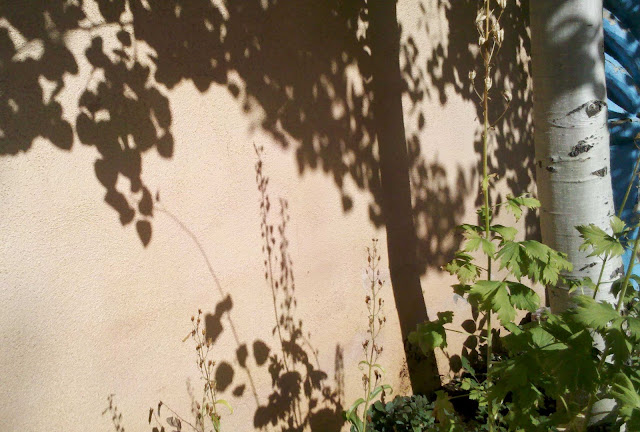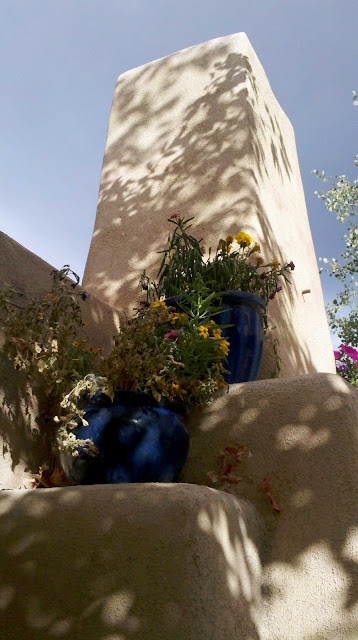Monday, October 31, 2011
Happy Booooo Day!
This fantastic giant spider sculpture was featured several years ago at Denver Botanic Gardens -
so sorry I don't remember the name of the artist!
ETA: Thanks to Panayoti Kelaidis:
I believe it was from David Roger's Big Bugs: check out http://www.big-bugs.com/Sites-Pages/Image13.html
Have a hauntingly fun Halloween!
Friday, October 28, 2011
Monday, October 24, 2011
Garden Designers' Roundtable: Darkness
The shadows know . . . !
 |
| a small courtyard garden is visually enlarged - and enhanced - by its shadow. Casa Benavides Inn, Taos, New Mexico |
As the days of autumn shorten, the low-slung sun casts longer and more distinctive shadows. The play between positive and negative space becomes more exaggerated; an even match for the color drama going on now, too.
Shadows help us see forms. Various textures and shapes reflect and collect light differently allowing us to distinguish unique elements amongst landforms, hardscapes and plants.
 |
| dunes at White Sands National Monument |
 | |||
| enhanced shadows expose the topography |
 |
| shadows created by the foliage texture of this kale help us analyze and understand the plant's form |
 |
| the variety of textures and forms in this garden create shadows that make it more readable |
Shadows cast upon a vertical surface create a multiplying effect that gives depth to a garden. They can also provide new interest and beauty to a blah surface.
 |
| Allium shadows on brushed stainless steel at Kevin Robb Studios |
 |
| the shadow of an tree creates the illusion of a climbing vine |
Shadows cast upon a horizontal surface heighten the textural nuances of the hardscape material and create a distorted echo of the item itself.
 |
| ghostly images from vintage iron posts enhance a plain-Jane concrete patio |
 |
| a lattice shadow on river pebbles has a watery distortion |
Another type of "shadow" is a silhouette. Items back-lit by the sun and viewed through a translucent screen have a fascinatingly different appearance - sometimes simplified, sometimes more complex. (Either way, it does give one the sense of having x-ray vision.)
 |
| hidden flower buds, exposed |
 |
| colors and shapes interplay like multiple layers of stained glass - Denver Botanic Gardens |
 |
| a tangle of grape vines, simplified |
Our landscapes are changing rapidly now. As autumn moves into winter, and darkness dominates our days, I hope you will seek out the shadows and enjoy their stories.
Please visit my fellow members of the Garden Designers' Roundtable for more inspiring ideas and information on our theme of Darkness:
Lesley Hegarty & Robert Webber : Hegarty Webber Partnership : Bristol, UK
Genevieve Schmidt : North Coast Gardening : Arcata, CA
Thanks to M. Zwalen and M. Komodore for allowing me to photograph their gardens!
Sunday, October 23, 2011
Fall Classic
Now
that we are well into the second month of fall, it’s time to get
serious about preparing the garden for winter. Here is a check list of
chores that I try to get done between late October and late November
before the distractions of the holidays and the onset of really cold
weather.
- Blow out automatic sprinkler system and insulate tap. Our first snow and hard freezes are predicted for mid-week, so get crackin'!
- Remove hoses from faucets; drain. Store hoses and sprinklers in a handy location for winter watering.
- Winterize water features. Drain, clean and store or cover fountains and pots. Remove plant debris from ponds and set up a bubbler (a submersible pump with a short piece of pipe attached to the outlet) to keep some surface area free of ice. Disconnect pumps to recirculating waterfalls---especially if the water volume is fairly low. Ice buildup can divert water and cause problems. Moving water will also make your pond colder, which may be an issue if you have fish.
- Empty all containers of annual flowers or veggies (add healthy vegetation to the compost pile, dispose of the rest). Remove soil – or the top 8-10” from large pots - (again, off to the compost pile!), and put containers into storage. My “storage” is the back corner of my covered patio. A shed or garage would also do the trick.
- Remove leaves from lawn areas. I rake my leaves directly into my garden beds for a loose, temporary mulch. I’ll remove them in the spring for composting. You can also run your lawn mower over them and leave them, or rake them up for mulch or to compost.
- Winterize lawn mower. After the last mowing, run it until the gas tank is empty. Clean mower and sharpen blade.
- Add organic soil amendments to planting beds.
- Plant bulbs. I'm planning to wait another week or two for this project; once the soil temperature cools down a bit more we'll be good to go.
- Wrap young trees. I don’t need to do this anymore, but here are the directions for “how-to”.
- Clean up/cut back perennials. I do most of this in the spring, because I like the structure and texture that many plants offer during dormancy.
Wednesday, October 19, 2011
Saturday, October 15, 2011
Garden Bloggers' Bloom Day 10.15.2011
 |
| Autumn purple ash, just about at its peak of color |
 |
| Zagreb coreopsis |
 |
| whirling butterflies |
 |
| plumbago |
 |
| Autumn Joy sedum |
 |
| Frosty Morn sedum |
 |
| Maximillian sunflower |
 |
| hummingbird flower |
 |
| poppy mallow |
Please visit Carol, at May Dreams Gardens, to see what's happening in her garden and those of other garden bloggers from around the world.
Wednesday, October 12, 2011
Sunday, October 09, 2011
Pink!
 |
| Aster 'Alma Potschke' |
Wednesday, October 05, 2011
Subscribe to:
Comments (Atom)













